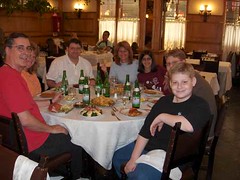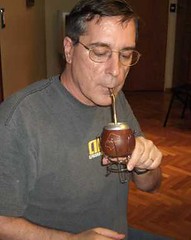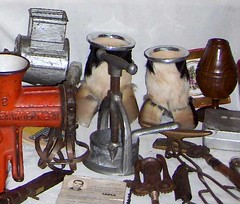Argentines are meat-eaters. The broad plains of the Pampas are ideal for raising cattle, and Argentine beef is revered all over the world. Argentine leather is highly prized because they don’t use barbed wire in Argentina, leaving the hides unscarred.
Because of the currency exchange rate, you can have a steak dinner for $4 - $5. The cuts of meat differ slightly from the U.S., but the standard options are “lomo” (filet mignon), “chorizo” (sirloin) and “vacio” (flank steak). The meat is usually grilled, and the traditional gaucho method is to skewer it on a long, sword-like bar and drive the pointed end into the earth beside a hot wood fire. Whole sides of beef are often set up this way, with cuts being sliced off as they are ordered. While this is dramatic and charming, it means that some of the meat may be cooked to the point of near-incineration.
Meal portions are enormous, and at one memorable dinner, Norberto’s cousin and his wife took home a package of leftover filet mignon the size of an Oxford Unabridged Dictionary which they intended to feed to their dog, Cero, who must have felt like he hit the lottery.
Since quality beef is so inexpensive and plentiful, Argentines take it for granted. You can get a filet mignon in any restaurant, no matter how small or off the beaten path. However, not all cuts of beef lend themselves to grilling, so the Argentines have a variety of other dishes that use the less desirable cuts. For one thing, cow guts are popular items found on the menu in every fine restaurant. We’re talking about kidneys, tripe, sweetbreads and blood sausage. Whenever I would ask what a particular beef dish actually was, Norberto’s cousin had this unnerving habit of pointing to himself to indicate where the item was removed from the cow.
They also do some weird things I have seen nowhere else. There’s a dish I tried called “matambre.” It’s made by taking two flat pieces of poached flank steak or brisket, sandwiching sliced hard-boiled eggs, carrots, spinach and onions between them, and then gradually squishing it flat over a period of several days in a press resembling a medieval torture device. This process squeezes out all of the juice, texture and flavor, producing a tough, dry, indigestible dish that is served cold to unwary diners.
However, the restaurant experience itself is wonderful. Waiters are seasoned professionals, always men over 40, always in crisp uniforms. They never write down an order, no matter how many in the party. Restaurants are clean, quiet and efficient. Norberto took us to a restaurant called the “Palacio de Papas Fritas,” which translates to “Palace of French Fries.” Now, you might assume this to be some kind of greasy burger joint adjacent to a carnival, but it’s a fine restaurant. They have a secret recipe for French fries that involves blanching in ice water. The result is delicate and puffy, like nothing I’ve tasted anywhere.

People in Argentina drink a lot of Coca-Cola and bottled water. There’s nothing wrong with the tap water, they just don’t drink it. However, the national drink is something called “yerba mate” (YER-bah MAH-tay), or just “mate” for short. It’s a kind of tea made from a South American plant, NOT from a tea plant. Norberto says it tastes like wet grass clippings, but everybody in Argentina drinks this stuff. Businessmen, policemen, shopkeepers – everybody drinks mate all day long. Argentines claim that there is no caffeine in mate, but I found it enervating.
Mate is an Argentine social lubricant, typically served among friends. First of all, you need a mate cup. A mate cup is traditionally made from a small brown gourd, often decorated with carvings and silver ornaments. However, they are also made of wood, ceramic, silver and my personal favorite, the hoof of a cow (here’s a picture of some we found in a flea market, nestled among the bric-a-brac). My wife absolutely refused to let me buy a cow-foot cup, so I wound up with a stupid old gourd with the word “Argentina” carved in it.
 |  |
When friends gather, one cup is brought out, and a spoonful of loose dried ground mate leaves is added. It looks a lot like oregano in loose form, but it’s also available in teabag form, although no self-respecting Argentine would prepare it that way. Then, sugar is added if desired, and you pour boiling water over it to fill the cup. A metal straw with a screen over the end is placed into the cup and you drink the mate until the cup is empty. Then you pass the cup to the next person, who pours boiling water over the mate again and consumes it. This continues until the mate loses its flavor. Then it’s dumped out and the entire process is repeated. I’ve been told that at larger gatherings, there may be three cups going around: One plain, one with sugar, and one with Sweet and Low.
People drink mate at work. I saw riot police at a political demonstration preparing mate in the back of a paddy wagon using a portable propane cooker. Everybody drinks it from traditional cups, not from ceramic coffee cups. There’s a story that a local bank created a rule banning mate consumption on the job, which was hastily rescinded when productivity fell through the floor.
I brought some mate teabags back with me, wondering if anyone would be interested in trying it. We saw police dogs sniffing the baggage when we entered the country, so I assume it doesn’t contain anything illegal.

No comments:
Post a Comment